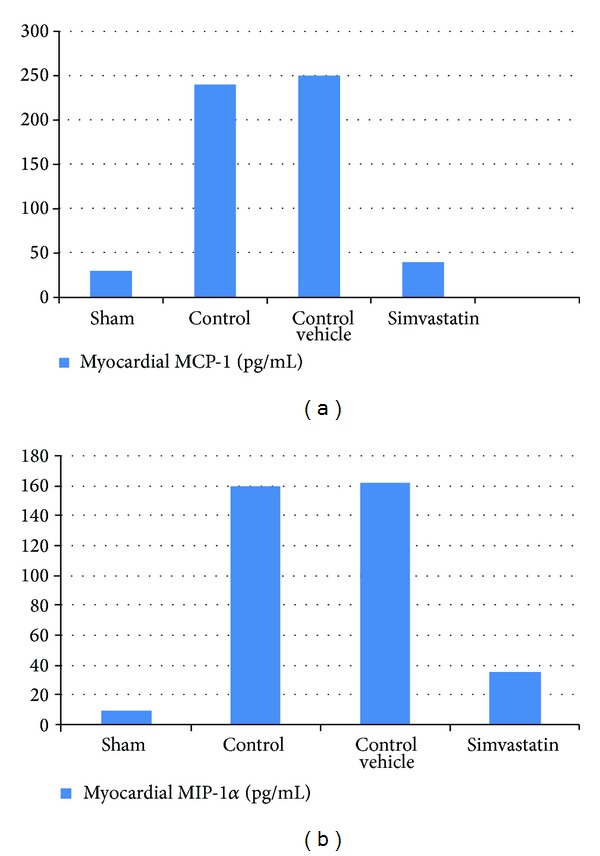Antiapoptotic effect of simvastatin ameliorates myocardial ischemia/reperfusion injury.
引用次数: 20
Abstract
Background. Myocardial ischemial reperfusion represents a clinically relevant problem associated with thrombolysis, angioplasty, and coronary bypass surgery. Injury of myocardium due to ischemial reperfusion includes cardiac contractile dysfunction, arrhythmias, and irreversible myocytes damage. These changes are considered to be the consequence of imbalance between the formation of oxidants and the availability of endogenous antioxidants in the heart. Objective. This study was undertaken to investigate the potential role of Simvastatin in the amelioration of myocardial I/R injury induced by ligation of coronary artery in a rat model. Materials and Methods. Adult male Swiss Albino rats were randomized into 4 equal groups. Group (1): sham group: rats underwent the same anesthetic and surgical procedures as those in the control group except ligation of LAD coronary artery, group (2): control group: rats were subjected to regional ischemia for 25 min and reperfusion for 2 hours by ligation of LAD coronary artery, group (3): control vehicle group: rats received vehicle of Simvastatin (normal saline) via IP injection and were subjected to regional ischemia for 25 min and reperfusion for 2 hours by ligation of LAD coronary artery, group (4): Simvastatin treated group: rats were pretreated with Simvastatin 1 mg/kg i.p. 1 hr before ligation of LAD coronary artery. At the end of experiment (2 hr of reperfusion), blood samples were collected from the heart for the measurement of plasma level of cardiac troponin I (cTnI). After that the heart was harvested and divided into 3 parts; one part was used for measurement of apoptosis, another part was homogenized for the measurement of tissue tumor necrosis factor-α (TNF-α), interleukin-1β (IL-1β), interleukin-6, monocyte chemoattractant protein-1, and macrophage inflammatory protein-1α, and the last part for histopathology study. Results. Compared with the sham group, levels of myocardial TNF-α and IL-1β, IL-6, MCP-1, and MIP-1α and plasma cTnI were increased (P < 0.05). Histologically, all rats in control group showed significant (P < 0.05) cardiac injury. Furthermore, all rats in control group showed significant (P < 0.05) apoptosis. Simvastatin significantly counteracted the increase in myocardium level of TNF-α, IL-1B, IL-6, MCP-1 and MIP-1α, plasma cTnI, and apoptosis (P < 0.05). Histological analysis revealed that Simvastatin markedly reduced (P < 0.05) the severity of heart injury in the rats that underwent LAD ligation procedure. Conclusions. The results of the present study reveal that Simvastatin may ameliorate myocardial I/R injury in rats via interfering with inflammatory reactions and apoptosis which were induced by I/R injury.



辛伐他汀对心肌缺血再灌注损伤的抗凋亡作用。
背景。心肌缺血再灌注是一个与溶栓、血管成形术和冠状动脉搭桥手术相关的临床问题。缺血再灌注引起的心肌损伤包括心肌收缩功能障碍、心律失常和不可逆的心肌细胞损伤。这些变化被认为是氧化剂形成和心脏内源性抗氧化剂可用性之间不平衡的结果。目标。本研究旨在探讨辛伐他汀在改善大鼠冠状动脉结扎所致心肌I/R损伤中的潜在作用。材料与方法。将成年雄性瑞士白化病大鼠随机分为4组。组(1):假手术组:除LAD冠状动脉结扎外,其余麻醉和手术过程与对照组相同;组(2):对照组:结扎LAD冠状动脉局部缺血25 min,再灌注2小时;组(3):对照组:大鼠经IP注射辛伐他汀(生理盐水)载药,局部缺血25 min, LAD冠状动脉结扎再灌注2小时,组(4):辛伐他汀治疗组:在LAD冠状动脉结扎前1小时,先用辛伐他汀1 mg/kg / p预处理。实验结束(再灌注2小时),取心脏血,测定血浆心肌肌钙蛋白I (cTnI)水平。之后,心脏被采集并分成3部分;一部分测定细胞凋亡,另一部分匀浆测定组织肿瘤坏死因子- α (TNF- α)、白细胞介素-1 β (IL-1 β)、白细胞介素-6、单核细胞趋化蛋白-1、巨噬细胞炎症蛋白-1 α,最后一部分进行组织病理学研究。结果。与假手术组比较,大鼠心肌TNF- α、IL-1 β、IL-6、MCP-1、MIP-1 α水平及血浆cTnI水平均升高(P < 0.05)。组织学上,对照组大鼠心肌损伤均显著(P < 0.05)。对照组大鼠细胞凋亡均显著(P < 0.05)。辛伐他汀显著抵消了心肌TNF- α、IL-1B、IL-6、MCP-1、MIP-1 α、血浆cTnI和细胞凋亡的升高(P < 0.05)。组织学分析显示辛伐他汀显著降低LAD结扎大鼠心脏损伤程度(P < 0.05)。结论。本研究结果表明辛伐他汀可能通过干预I/R损伤引起的炎症反应和细胞凋亡来改善大鼠心肌I/R损伤。
本文章由计算机程序翻译,如有差异,请以英文原文为准。
求助全文
约1分钟内获得全文
求助全文

 求助内容:
求助内容: 应助结果提醒方式:
应助结果提醒方式:


